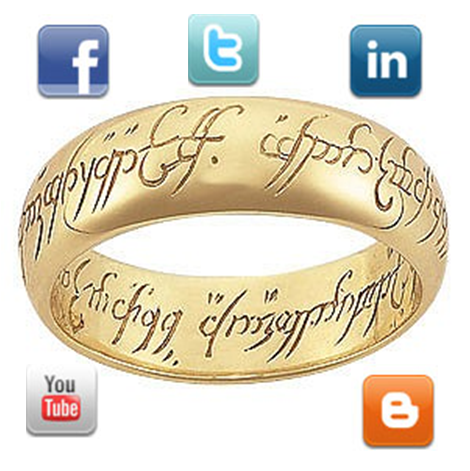Archive for April, 2012
#Gamification: One Ring to Rule Them All
Buzzword bingo and a fantasy literature reference all in one title? It’s almost too good to be true.
Thesis: Gamification is the Best Solution for Master User Identity Management
Gamification, and the creation of a separate and unique master user identity, provides the enterprise with the engine to connect a single individual’s entire portfolio of online identities.
Many marketers and professionals might follow such a bold statement with a series of assertions and opinions from gurus–I’m going to follow it with a problem statement and a Lord of the Rings analogy.

Master User Identity Management is a Serious Problem
The explosion of the web had an evolutionary impact on the way that an individual can interact with a brand. As a social media manager, and an optimist, I strongly believe this to be a lasting and positive impact. This positive evolution is not without its problems.

One of the largest of these problems involves Master User Identity Management. The term itself is long and unwieldy and simply aims to name a simple issue: there are too many of you. I use this not as the plural “you all” but as the singular and unique “you.” If your online self looks anything like me, you probably have at least:

Notice the issue? There are at least 5 different digital representations of me (or you). Luckily there is only one person with my name in the world–pretty cool–but what if my name was John Doe? Or Matt Smith? Good luck figuring out which of these pages actually belong to the digital me.
Gamification is the Solution to this Problem

“One Ring to rule them all, One Ring to find them,
One Ring to bring them all and in the darkness bind them”
What does a ring have to do with this?
Gamification is your one ring to rule them all. Ignore the fact that you have (at least) 5 different online identities–or the fact that every one of your audience members does too–and put your faith in the One Ring.
In Lord of the Rings, for the 4 of you that have not read/watched it, this one ring rules over all others. Even though many rings and power exist, the One Ring connects and commands them all. The main protagonist then spends hundreds of pages–or hours of film–trying to drop it in a volcano [Spoiler alert: he does].
Gamification Unites Your Identity Kingdom
A successful deployment of enterprise gamification builds a separate and unique identity for each of your online audience members. This is not another identity but rather the master identity itself. Think of this like a social security number–a single identity to which other identities and presences can be connected. Once this master identity is built, any and all other presences can and should be attached.
Deploying this One Ring must be done in stages, and carefully:
Stage 1: Select a Gamification Partner
My advice: select a vendor that appreciates the power of a fully-connected online ecosystem. Do not select one that has the best social strategy, the best community strategy, or the best web strategy–find the one that understands that, in the eyes of your audience, you are one entity.
My employer, EMC Corporation, will soon have news on this–but I will not be breaking it here. Sorry friends.
Stage 2: Establish the Master ID System
This ID can be based on almost any factor, from email to phone number to username, or it can be randomly generated and assigned. The most stable system creates this random identifier and then attaches all others to it.
Stage 3: Launch with Limited Connections
Launching enterprise gamification is not an easy endeavor. It requires careful calculation and attention and I strongly suggest focusing on one platform for program launch. At EMC, we made the choice to launch first on our external community platform. Part of this decision depends on the point of entry for your company’s program. If you happen to be a web manager, I’ll guess you would suggest a web-first strategy, and I wouldn’t blame you. I happen to be on the social and community team, so we plan to start there [More news soon friends].
Stage 4: Take over the World
I mentioned that I’m an optimist, didn’t I? Following a successful launch, the race is on to motivate users to connect this master identity to all other identities. Most users will not do so without proper motivation. As a gamificator, you hold the most powerful motivator of all: ego. Connecting the master identity to all of the auxiliary identities (Facebook, Twitter, etc.) allows a gamification manager to create a status that fully represents that users interaction.
Users Interact with One Brand–Give Them One Status-Based Identity to Go With It

Your online audience does not perceive 15 versions of your brand–they perceive one. It is time that the enterprise delivered a single status to pair with this perception–a status that rewards, recognizes, and motivates desired behaviors while also materially improving the user experience. Gamification is our weapon in this big data conflict–our One Ring to rule them all.
Closing Caveat: Gamification is About Balance
Well-executed gamification is a mutually beneficial relationship between the enterprise’s goals (increasing interaction and understanding behaviors) and the user’s desires (an improved user experience). If at any point the balance tips, the program fails. This post, however, aims to primarily address the enterprise perspective.
